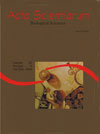<b>Gonadal development of jundiá, <em>Rhamdia quelen</em>(Teleostei, Siluriformes), in earthen ponds in southern Brazil</b> - DOI: 10.4025/actascibiolsci.v29i4.881
Abstract
The study characterized the gonadal development of jundiá from approximately 8 g until gonadal maturation, to provide further knowledge for farming jundiá in Southern Brazil. Jundiá fingerlings (average weight 8.00 ± 3.73 g) were stocked in three ponds at 0.6 fish m-2. Fourteen fish were sampled each month from September 2001 to October 2002. Gonadal maturation stages were characterized macroscopically, and samples of ovaries and testicles were fixed in 4-%-buffered formalin for histological examination. One hundred and eighteen fish were analyzed: 60 males e 58 females. Jundiá males matured earlier than females. Testicles and ovaries presented similar morphology to other Siluriformes species. Gonads were classified in four development phases of the ovarian follicle, according to histology: immature, initial maturation, final maturation and mature. The gonadosomatic index varied from 0.29 to 9.16 for males and from 0.11 to 13.03 for females. Mature individuals were observed during summer (December/2001 and January/2002), fall (April and May/2002) and spring (September and October/2002), following the increase in water temperature.Downloads
Download data is not yet available.
Published
2008-02-21
How to Cite
Ghiraldelli, L., Machado, C., Fracalossi, D. M., & Filho, E. Z. (2008). <b>Gonadal development of jundiá, <em>Rhamdia quelen</em>(Teleostei, Siluriformes), in earthen ponds in southern Brazil</b> - DOI: 10.4025/actascibiolsci.v29i4.881. Acta Scientiarum. Biological Sciences, 29(4), 349-356. https://doi.org/10.4025/actascibiolsci.v29i4.881
Issue
Section
Aquiculture and Fisheries Resources
DECLARATION OF ORIGINALITY AND COPYRIGHTS
I Declare that current article is original and has not been submitted for publication, in part or in whole, to any other national or international journal.
The copyrights belong exclusively to the authors. Published content is licensed under Creative Commons Attribution 4.0 (CC BY 4.0) guidelines, which allows sharing (copy and distribution of the material in any medium or format) and adaptation (remix, transform, and build upon the material) for any purpose, even commercially, under the terms of attribution.
Read this link for further information on how to use CC BY 4.0 properly.
0.6
2019CiteScore
31st percentile
Powered by 

0.6
2019CiteScore
31st percentile
Powered by 











1.png)




3.png)













